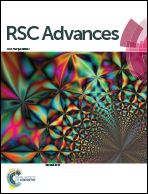Role of a “surface wettability switch” in inter-fiber bonding properties
Abstract
The fiber surface wettability is one of the most important lignocellulosic fiber characteristics affecting the inter-fiber bonding properties of final bio-products. In this study, the surface wettability (evaluated by the surface free energy, surface lignin and surface charge) of mechanically refined fibers and the bonding properties of the fiber matrix (handsheets) were measured and correlated to each other. The results showed that the fiber surface charge increased from 48.38 mmol kg−1 to 60.38 mmol kg−1 and the surface lignin decreased from 87.1% to 77.5% during the fiber mechanical treatment, leading to the improvement of the fiber surface free energy from 46.63 mJ m−2 to 54.45 mJ m−2. As a result, the bonding strength index increased from 2.60 N m g−1 to 9.73 N m g−1 without significant loss of bulk properties. In a word, the fiber surface wettability could be adjusted to facilitate the inter-fiber bonding properties of the paper or paperboard products using lignin-rich fibers as raw materials.



 Please wait while we load your content...
Please wait while we load your content...